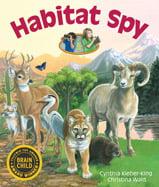Alignment to Standards for WA

| Grade | Number | Standard |
|---|---|---|
| 2 | SS-2.3.1.2a. | physical characteristics such as rivers, lakes, mountains, and parks of the community in which they live. |
| 2,3 | 2-3 LS2A | Ecosystems support all life on the planet, including human life, by providing food, fresh water, and breathable air. |
| 3 | SS-3.3.1.2a. | Explains the physical geography, including landforms and climate, of Mexico, Canada, and the U.S. |
| 4,5 | 4-5 LS1A | Plants and animals can be sorted according to their structures and behaviors. |
| 4,5 | 4-5 LS1B | Plants and animals have different structures and behaviors that serve different functions. |
| 4,5 | 4-5 LS1C | Certain structures and behaviors enable plants and animals to respond to changes in their environment. |
| 4,5 | 4-5 LS1D | Plants and animals have structures and behaviors that respond to internal needs. |
| 4,5 | 4-5 LS2A | An ecosystem includes all of the populations of living organisms and nonliving physical factors in a given area. Living organisms depend on one another and the nonliving physical factors in their ecosystem to help them survive. |
| 4,5 | 4-5 LS3B | Plants and animals inherit many characteristics from their parents. Some inherited characteristics allow organisms to better survive and reproduce in a given ecosystem. |
| 4,5 | 4-5 LS3C | Some characteristics and behaviors result from an individual plantês or animalês interactions with the environment and are not passed from one generation to the next by heredity. |
| K,1 | K-1 ES2A | Some objects occur in nature; others have been designed and processed by people. |
| K,1 | K-1 LS1B | All plants and animals have various external parts. |
| K,1 | K-1 LS1D | Different animals use their body parts in different ways to see, hear, grasp objects, and move from place to place. |
| K,1 | K-1 LS1E | Animals have various ways of obtaining food and water. Nearly all animals drink water or eat foods that contain water. |
| K,1 | K-1 LS2A | There are different kinds of natural areas, or habitats, where many different plants and animals live together. |
| K,1 | K-1 LS2B | A habitat supports the growth of many different plants and animals by meeting their basic needs of food, water, and shelter. |
| K,1 | K-1 LS3A | Some things are alive and others are not. |
| K,1 | K-1 LS3A.a | Use logical rules to sort objects into two groups, those that are alive and those that are not. |
| K,1 | K-1 LS3B | There are many different types of living things on Earth. Many of them are classified as plants or animals. |
| K,1 | K-1 LS3C. | External features of animals and plants are used to classify them into groups. |
| K,1 | K-1 LS3C.1 | Describe several external features and behaviors of animals that can be used to classify them (e.g., size, color, shape of body parts). |
| K,1 | K-1 LS3C.3 | how pairs (males/females) of plants and/or animals are similar to and different from each other (e.g., cats and dogs both have four legs, but many dogs have longer snouts than cats). |
| K,1 | K-1 SYSA | Living and nonliving things are made of parts. People give names to the parts that are different from the name of the whole object, plant, or animal. |